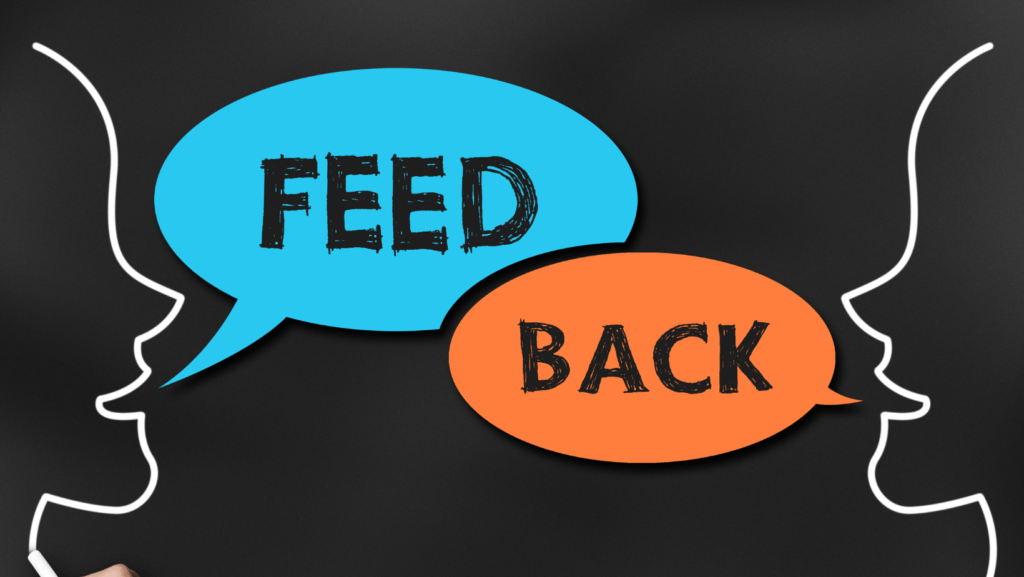
Feedback is a powerful tool for you as an agile coach, both if you are giving and receiving. But with any powerful tool comes misunderstanding.
So today, let’s break down what feedback really is, what people often get wrong, and two feedback models to help you deliver it.
If you’d rather watch a video than read, check out my youtube video on this topic here:
Table of Contents
ToggleWhat is feedback?
“Feedback is what occurs when outputs of a system are routed back as inputs as part of a chain of cause-and-effect that forms a circuit or a loop. The system can then be said to feed back into itself.” Source, Wikipedia.
So basically, there is an action and a reaction. In the context of organizations, feedback is either the action we take or the reaction of other people or processes around us after we take action. When you take an action, do something or say something, do the procedures allow you to do so? Or do you have a problem now? How do other people feel?
Feedback relates to performancee as individuals, teams, or the organization at large. We aren’t talking about appraisals here, although feedback is used in those circumstances as well. If you had a meeting with someone and a colleague gives you feedback about what happened in that session, that is feedback. It doesn’t need to be a complete, all-encompassing, performance review you receive once a year.
Feedback is a normal part of your day-to-day as an agile coach and is instrumental in building trust with your teams.
So it’s not uncommon to be wondering how to give feedback in a useful and effective way.
What do people get wrong about feedback?
Feedback is not an opinion
In today’s culture of organizations, it’s important to understand that feedback is different than an opinion. When you give your opinions, think about what they are going to cause. If you are giving opinions to each other all the time, it can be overwhelming and not necessarily valid or constructive. If you say something is “good” or “bad”, that is a personal opinion and is not feedback. Remember, you are expected to put feedback back into the system so it can make a change. In order for it to be feedback, it has to be more structured.
You don’t have to act immediately on feedback
You are not required to act on the feedback you receive. In fact, I recommend that you don’t. We often act too fast on things that we see or receive. We are working in complex teams and organizations where things may not always be what they seem. Sometimes things happen that are a-typical. Maybe one day you rushed to deliver something and received feedback on it to slow down, but this was not your normal behavior. You might start feeling like you have a problem and overthinking it, but in fact it was just this one situation. You don’t need to feel worried that you have to improve. Listen to what people say, gain that awareness, and thank them, but notice trends. Allow yourself to receive a lot of feedback before you decide to act. This allows you to zoom out and notice patterns and what things happen consistently. Those are the things that you should focus on improving or changing.
Feedback isn’t only about what is wrong
Often, the only feedback we receive is negative. Many people seem to think that giving feedback is just talking about the bad stuff – a misstep or something you didn’t deliver quite right. Yes, those things are a part of feedback but how often are you told something you did very well? It is important to notice the trends in the positives so you can keep up with those things as well! Feedback isn’t only about the bad and constructive things.
Two awesome feedback models
The strength-based feedback model
This model comes from the world of therapy and was invented by a team from the University of Kansas. What I love about this model is that it’s all about amplifying what already works well.
These scientists noticed that the most amazing patient would get better by focusing on the things that were already going well, and that people who were excellent programmers focus on what makes them amazing and they double-down on that. They don’t abandon their weaknesses, but this model tells you that if you have something to improve on, make sure you borrow from the place where you have strengths. It is about resourcefulness instead of lack.
For example, you just had a budget meeting and you noticed that a colleague was amazing at scrutinizing the numbers and helping the team stay organized. Make sure to mention that to them and tell them that you were impressed by their ability with numbers. You are giving them nice and precise instruction on how they helped the group. This person now knows and this can help build their confidence.
Conversely, you can use the ability of someone to help them understand where they fall short. For example, there was a meeting and maybe the same colleague was distracted. After this call you can tell them that usually they are so amazing in their contributions because they are so precise and clear, so you wonder what is it we could do so they can participate more in the meetings. You can phrase it as what can you do to help them succeed in the meeting because they have really great ideas.
To use this model, you can’t just go in and criticize. Even if you have constructive feedback, you also have to notice their strengths and what works, first.
SBI model
SBI stands for Situation, Behavior, and Impact. In this model you are trying to give the situation, the behavior, and the impact, or the full context for the feedback. It helps you format feedback in a contextual way and avoid just giving opinions, and it helps the receiver really understand the feedback.
If you are giving negative feedback, you’ll have to say when, what, and what happened as a result. For example, in yesterday’s meeting, when you shared our private conversation with the group, I felt insecure and frustrated. You are being very clear on the impact that their behavior had. That person can then decide what to do with that info.
When delivering positive feedback, it works great as well. For example, in yesterday’s meeting, when you supported my idea, I felt confident and encouraged. The full context allows the receiver to marinate on it and act accordingly.
There are many more models like the CEDAR model or the STAR model, but these are two that I really love. One important thing to mention though is that not all feedback models give you an idea of how to suggest improvement. Personally, I like that. I don’t think that you, as someone giving feedback, should be giving insight as to how they should improve, unless they specifically ask for it. The coach in me doesn’t like to advise how to proceed, I can only inform you of what I saw. To me, giving the advice after the feedback falls out of the realm of feedback. It’s up to the receiver to decide what to do with the information.
So how do you give feedback
Feedback is a tool for organizations to develop people and improve their performance. Think about it as a gift. Are you giving gifts to everybody, everywhere, all the time? It’s not likely. Use feedback sparingly, intentionally, and wrap it nicely by thinking about the why and the how of delivery. Always consider the intention and that you want the person to feel they received something valuable from you.
If you are interested in learning about how to coach for team development and success, check out my Agile Coaching Program! It’s a month-long course of learning by doing! We have recently amped up the conflict navigation, team development, and agile principles in practice areas of the course so it is truly better than ever. In addition, we are proud partners with ICAgile so you will receive a highly recognized certification upon completion that will set you up well for a career as an agile coach.



